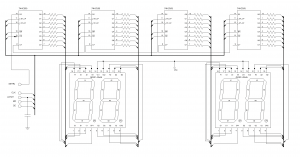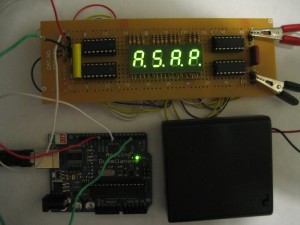I was inspired by Paul’s 7 segment display and decided to build one myself. He used 4 common cathode 7 segment displays. In his original schematics, all the segments within a display shared one current limiting resistor which unfortunately affect the display brightness when different numbers of segments are lit. I happened to have two common anode dual 7 segment displays (QDSP-G545) so I decided to use them and four 74HC595 shift registers to build a four 7-seg display. Realizing that other people might be using either common anode or common cathode displays, I also built a library that can be used for either case.
Without further due, here’s the schematics of the 4 digit 7 segment display (click for higher resolution pictures):

For finer controls, I left the MR OE pins (pin 10 and 13) unconnected so that they can be controlled by program. But for general use, you can connect pin 10 (MR) to Vcc and pin 13 (OE) to ground so that the output is always enabled.
Here’s the finished display (the letters displayed are “A.S.A.P”)

It is fairly straight forward to write programs to interact with the above 4 digit display. The following C code offers a simple method disp() to display letters/digits that are predefined (see the comment section before the code and you will get an idea how to build your own symbols other than the ones included). The four boolean variables (dot1 to dot4) are used to turn on the decimal point on each segment independent of what is being displayed.
//aaaaaa
//f b
//fggggb
//e c
//eddddc p
// abcdefgp ~abcdefgp DEC ~DEC
//1 00001100 11110011 12 243
//2 11011010 00100101 218 101
//3 11110010 00001101 242 13
//4 01100110 10011001 102 153
//5 10110110 01001001 182 73
//6 10111110 01000001 190 65
//7 11100000 00011111 224 31
//8 11111110 00000001 254 1
//9 11110110 00001001 246 9
//0 11111101 00000010 253 2
//A 11101110 00010001 238 17
//b 00111110 11000001 62 193
//c 00011010 11100101 26 229
//C 10011100 01100011 156 99
//d 01111010 10000101 122 133
//e 11011110 00100001 222 33
//E 10011110 01100001 158 97
//F 10001110 01110001 142 113
//g 11110110 00001001 246 9
//H 01101110 10010001 110 145
//h 00101110 11010001 46 209
//I 01100000 10011111 96 159
//J 01111000 10000111 120 135
//L 00011100 11100011 28 227
//n 00101010 11010101 42 213
//o 00111010 11000101 58 197
//P 11001110 00110001 206 49
//q 11100110 00011001 230 25
//r 00001010 11110101 10 245
//S 10110110 01001001 182 73
//t 00011110 11100001 30 225
//u 00111000 11000111 56 199
//U 01111100 10000011 124 131
//y 01110110 10001001 118 137
//- 00000010 11111101 2 253
//- 10000000 01111111 128 127
//- 00010000 11101111 16 239
//. 00000001 11111110 1 254
//|| 01101100 10010011 108 147
//= 10010000 01101111 144 111
//= 10000010 01111101 130 125
//= 00010010 11101101 18 237
//=- 10010010 01101101 146 109
int latchPin = 10;
int clockPin = 7;
int dataPin = 3;
//note that for common cathode displays the
//bit values are inverted (see code)
const int COMMON_ANODE = 1; //1 CA, 0 CC
struct CharMap
{
char c;
byte v;
};
const int cmap_len = 41;
struct CharMap cmap[] = {
{' ', 0},
{'1', 12},
{'2', 218},
{'3', 242},
{'4', 102},
{'5', 182},
{'6', 190},
{'7', 224},
{'8', 254},
{'9', 246},
{'0', 253},
{'A', 238},
{'b', 62},
{'c', 26},
{'C', 156},
{'d', 122},
{'e', 222},
{'E', 158},
{'F', 142},
{'g', 246},
{'H', 110},
{'h', 46},
{'I', 96},
{'J', 120},
{'L', 28},
{'n', 42},
{'o', 58},
{'P', 206},
{'q', 230},
{'r', 10},
{'S', 182},
{'t', 30},
{'u', 56},
{'U', 124},
{'y', 118},
{'-', 2},
{'~', 128},
{'_', 16},
{'.', 1},
{'|', 108},
{'=', 144}
};
byte getCode(char c)
{
byte r = 2;
for (int i = 0 ; i < cmap_len ; i++) {
if (c == cmap[i].c) {
r = cmap[i].v;
break;
}
}
return r;
}
//display c1 c2 c3 c4
//Note the boolean values for dot1 dot2 dot3 and dot4
//indicates whether or not to show the decimal point
void disp(char c1, bool dot1, char c2, bool dot2, char c3, bool dot3, char c4, bool dot4)
{
byte b1 = getCode(c1);
byte b2 = getCode(c2);
byte b3 = getCode(c3);
byte b4 = getCode(c4);
if (dot1 == true) b1 += 1;
if (dot2 == true) b2 += 1;
if (dot3 == true) b3 += 1;
if (dot4 == true) b4 += 1;
if (COMMON_ANODE == 1) {
b1 = 255 - b1;
b2 = 255 - b2;
b3 = 255 - b3;
b4 = 255 - b4;
}
digitalWrite(latchPin, LOW);
shiftOut(dataPin, clockPin, b4);
shiftOut(dataPin, clockPin, b3);
shiftOut(dataPin, clockPin, b2);
shiftOut(dataPin, clockPin, b1);
digitalWrite(latchPin, HIGH);
}
void setup7seg()
{
pinMode(latchPin, OUTPUT);
pinMode(clockPin, OUTPUT);
pinMode(dataPin, OUTPUT);
disp(' ', false, ' ', false, ' ', false, ' ', false);
}
void shiftOut(uint8_t dataPin, uint8_t clockPin, byte val)
{
int i;
for (i = 0; i < 8; i++) {
digitalWrite(dataPin, (val & _BV(i)));
delayMicroseconds(10);
digitalWrite(clockPin, HIGH);
delayMicroseconds(10);
digitalWrite(clockPin, LOW);
delayMicroseconds(10);
}
}
void setup()
{
setup7seg();
}
void loop()
{
disp('d',false,'I',false,'S',false,'C',false); //displays the word dISC
delay(1000);
}
The shiftOut method is actually included in standard Arduino libraries, the reason I included it in my code is that I had to add slight delay between each digitalWrite otherwise the output is not always correct. I suspect this is due to the long wiring I used on the circuit board.
See also: An 8-Digit 7 Segment Display

